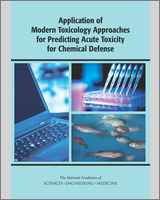NCBI Bookshelf. A service of the National Library of Medicine, National Institutes of Health.
Committee on Predictive-Toxicology Approaches for Military Assessments of Acute Exposures; Committee on Toxicology; Board on Environmental Studies and Toxicology; Board on Life Sciences; Division on Earth and Life Studies; The National Academies of Sciences, Engineering, and Medicine. Application of Modern Toxicology Approaches for Predicting Acute Toxicity for Chemical Defense. Washington (DC): National Academies Press (US); 2015 Sep 1.

Application of Modern Toxicology Approaches for Predicting Acute Toxicity for Chemical Defense.
Show detailsThe US Department of Defense (DOD) is faced with an overwhelming task in evaluating chemicals that could potentially pose a threat to its deployed personnel. There are over 84,000 registered chemicals, and testing them with traditional toxicity-testing methods is not feasible in terms of time or money. In recent years, there has been a concerted effort to develop new approaches to toxicity testing that incorporate advances in systems biology, toxicogenomics, bioinformatics, and computational toxicology. Given the advances, DOD asked the National Research Council (NRC) to determine how DOD could use modern approaches for predicting chemical toxicity in its efforts to prevent debilitating, acute exposures to deployed personnel.
In this report, the Committee on Predictive-Toxicology Approaches for Military Assessments of Acute Exposures provides an overall conceptual approach that DOD could use to develop a predictive-toxicology system. It reviews the current state of computational and high-throughput approaches for predicting acute toxicity and suggests methods for integrating data and predictions. It concludes with lessons learned from current high-throughput screening programs and suggests some initial steps for DOD investment.
This report has been reviewed in draft form by persons chosen for their diverse perspectives and technical expertise in accordance with procedures approved by the NRC Report Review Committee. The purpose of the independent review is to provide candid and critical comments that will assist the institution in making its published report as sound as possible and to ensure that the report meets institutional standards of objectivity, evidence, and responsiveness to the study charge. The review comments and draft manuscript remain confidential to protect the integrity of the deliberative process. We thank the following for their review of this report: Ellen Berg, BioSeek, Inc.; David Clapham, Harvard University; Mark Cronin, Liverpool John Moores University; Yvonne Dragan, DuPont; John Jenner, Defence Science and Technology Laboratory; Charles Santerre, Purdue University; Rusty Thomas, US Environmental Protection Agency; Ken Turtletaub, Lawrence Livermore National Laboratory; Daniel Wilson, The Dow Chemical Company; and Menghang Xia, National Center for Advancing Translational Sciences.
Although the reviewers listed above have provided many constructive comments and suggestions, they were not asked to endorse the conclusions or recommendations, nor did they see the final draft of the report before its release. The review of the report was overseen by the review coordinator, David Eaton, University of Washington, and the review monitor, Mark Cullen, Stanford University. Appointed by the NRC, they were responsible for making certain that an independent examination of the report was carried out in accordance with institutional procedures and that all review comments were carefully considered. Responsibility for the final content of the report rests entirely with the committee and the institution.
The committee gratefully acknowledges the following for their presentations to the committee during open sessions: Alison Director-Myska, Defense Threat Reduction Agency, and Keith Houck, US Environmental Protection Agency.
The committee is grateful for the assistance of the National Research Council staff in preparing this report. Staff members who contributed to the effort are Ellen Mantus, project director; Marilee Shelton-Davenport, senior program officer; Keri Stoever, research associate; James Reisa, director of the Board on Environmental Studies and Toxicology; Norman Grossblatt, senior editor; Mirsada Karalic-Loncarevic, manager of the Technical Information Center; Radiah Rose-Crawford, manager of editorial projects; and Ivory Clarke, senior program assistant.
I especially thank the members of the committee for their efforts throughout the development of this report.
David Dorman, Chair
Committee on Predictive-Toxicology Approaches for Military Assessments of Acute Exposures
- Preface - Application of Modern Toxicology Approaches for Predicting Acute Toxic...Preface - Application of Modern Toxicology Approaches for Predicting Acute Toxicity for Chemical Defense
Your browsing activity is empty.
Activity recording is turned off.
See more...